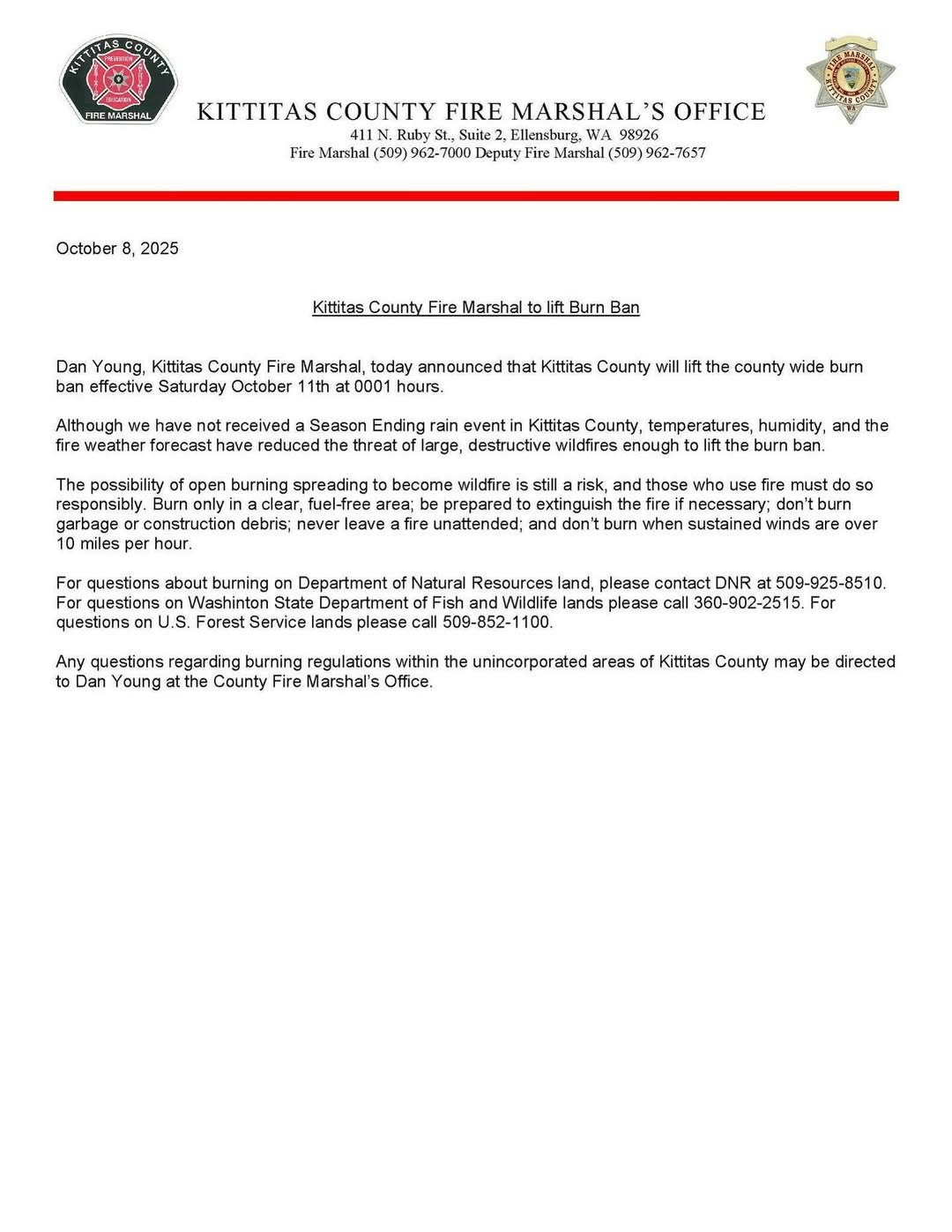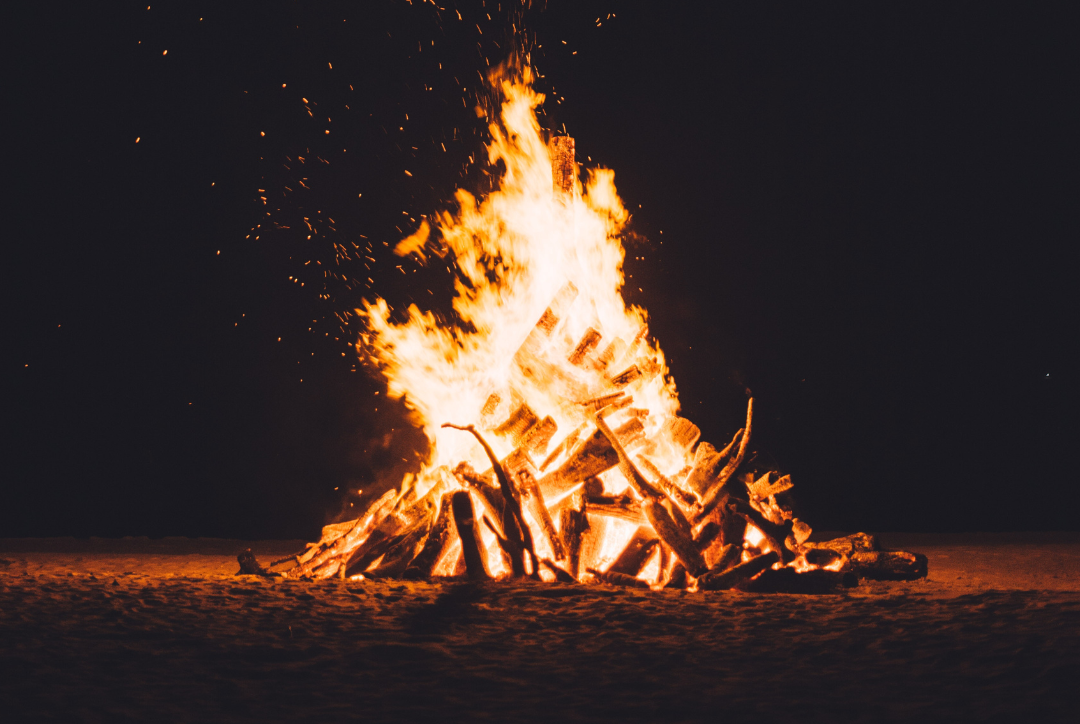Burn Ban Infomation
COUNTY BURN BAN WAS LIFTED 10/11/2025

COUNTY BURN REGULATIONS
Kittitas County Fire District 7 would like to remind our community of the rules for open burning as we are no longer in a burn ban. As always, if you choose to burn, please do so in a safe manner.
Attached are the County regulations for burning from Kittitas County Fire Marshal's Office:
§ 20.07.030. Piles of natural vegetation for burning
Piles of natural vegetation for burning shall be no greater than 10' in diameter, and no more than 10' in height. If prior approval is obtained by the Fire Marshal and local fire district, pile sizes may be increased. It shall be the responsibility of the property owner to contact the local fire district to determine if a permit will be required, as well as to notify the fire district upon commencement of burning.
The following rules shall apply
to all Outdoor Burning at all times:
1. The burning of garbage, trash, rubbish, or utilization of burn barrels, etc. is illegal
2. No open burning within 50 feet of any structure or combustible material;
3. Pile size shall be no greater than 10' in diameter, unless prior approval to increase pile size is obtained from the Fire Marshal and fire district;
4. No more than one pile may be burned on any property at the same time;
5. Piles may be stored on a property no longer than twelve months;
6. Conditions that may cause the fire to spread shall be eliminated prior to ignition;
7. No open burning shall occur when wind speeds or gusts exceed 10 mph, unless prior approval is obtained by the Fire Marshal and local fire district:
8. A person capable of utilizing fire extinguishing equipment such as buckets, shovels, garden hoses connected to a water supply, fire extinguishers, heavy equipment, etc.,
shall be on site at all times; and
9. Fire extinguishing equipment such as buckets, shovels, garden hoses connected to a water supply, fire extinguishers, heavy equipment or any equipment that will provide suppression of the proposed fire, shall be on site at all times while the fire
is burning. (Ord. 2010-005, 2010)
§ 20.07.040. Recreational fires.
Recreational fires are allowed in unincorporated areas of Kittitas County, provided that no restrictions or burn bans are in effect. The following rules for Recreational Fires shall
apply at all times:
1. Recreational fires, camp fires, cook fires, etc. shall be no greater than 3' x 3' in diameter and no more than 2' in height;
2. No recreational fires shall be located within 25 feet of any structure;
3. A person capable of utilizing fire extinguishing equipment such as buckets, shovels, garden hoses connected to a water supply, fire extinguishers, heavy equipment, etc.,
shall be on site at all times; and
4. Fire extinguishing equipment such as buckets, shovels, garden hoses connected to a water supply, fire extinguishers, heavy equipment or any equipment that will provide suppression of the proposed fire, shall be on site at all times while the fire

What a burn ban means?
The information listed below is general parameters dealing with a burn bans. Specific information related to any current ban will be updated as soon as available and posted on the main page.
Fire Safety Burn Bans (typically called for in the summer)
The county Fire Marshal, works with the DNR, Forest Service and various fire districts when declaring a fire safety burn ban. When the fire danger reaches a critical level the potential for large scale wildfires increases dramatically and this is often the trigger point for a burn ban. For most of us, including the public, this is easy to understand. Fire districts are not required to follow the county burn ban but since the Taylor Bridge Fire, most do. To make it more complicated DNR, Forest Service and National Parks may implement their own burn bans that do not always follow the counties.
Air Quality Burn Bans (typically called for in the fall and winter)
Air quality burn bans are currently regulated by Washington State Department of Ecology although local jurisdictions do have the authority to implement their own system provided it does not reduce public safety. Determining when a burn ban is imposed and at what level is achieved by actual air monitoring and weather forecasting, typically no more than two days out.
There are different levels of burn bans.
- DOE permit holder burn bans: Applies to larger outdoor debris and agriculture burns that would require a DOE permit and tend to produce large quantities of smoke. These bans do not include recreational fires, fire places or wood stoves.
- Stage 1 Burn Ban: This is the next highest level and includes DOE permit holders, recreation-al fires, uncertified wood stoves and fire places. Exemptions are granted to homes that use wood stoves or fireplaces as their sole source of heat.
- Stage 2 Burn Ban: This is the highest level burn ban and includes all burning except when the smoke is produced from homes where the sole source of heating is from a wood stove. In Upper Kittitas County these are typically days of severe air stagnation with fog and no wind. Air quality burn bans are often difficult to understand since the pollution being measured is 2.5 microns and smaller, that is 1/30th the diameter of an average human hair, so we can’t see it. However if you have respiratory issues you know on these days breathing is more difficult and even the average person can smell the heavy smoke hanging in air.
Burn bans - Washington State Department of Ecology
Department of Natural Resources (DNR)
